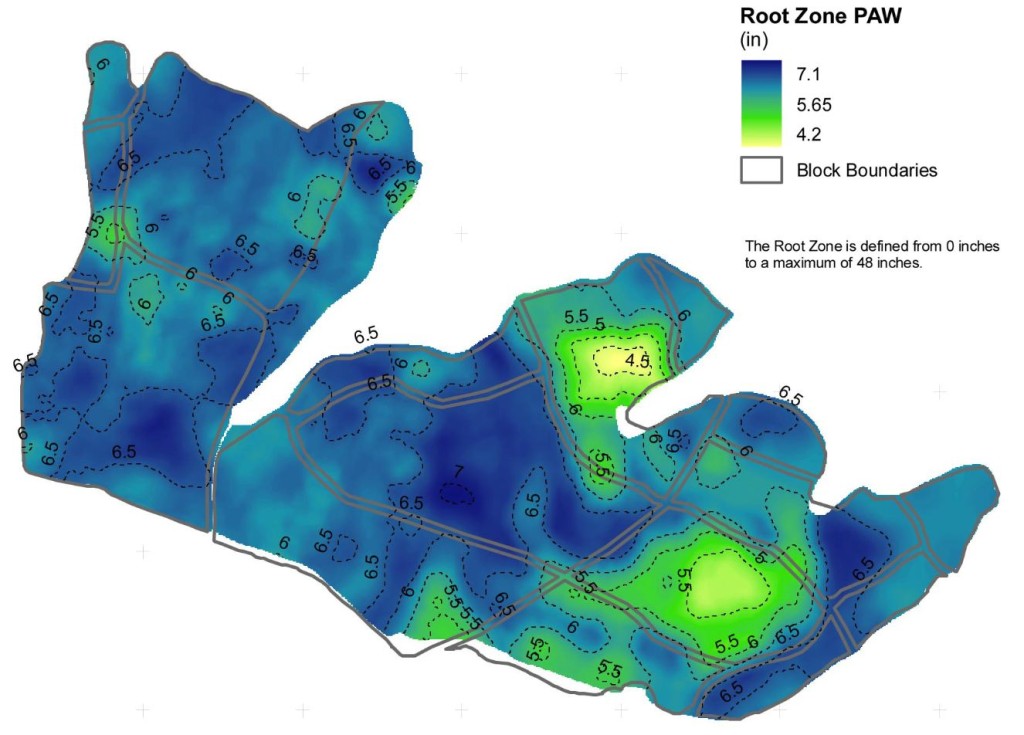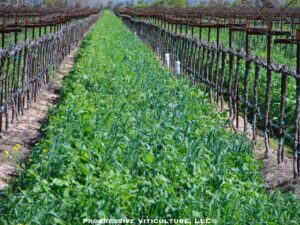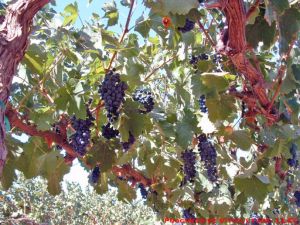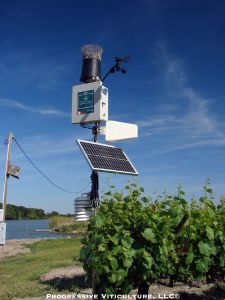 Those of us involved in agriculture are well aware of the increasing concerns about water in California. Even before the current drought, new water regulations were in the works, irrigation district water costs were increasing, and in many locations, access to groundwater supplies required deeper drilling than in the past. Going forward, there is no doubt vineyard water use will require our very best management skills. Now more than ever, our fundamental water management challenge is maximizing the benefits of winter rainfall during our dry growing seasons (fig. 1). To that end, this article presents a comprehensive approach to vineyard water management with an emphasis on soil water conservation and vineyard water use efficiency.
Those of us involved in agriculture are well aware of the increasing concerns about water in California. Even before the current drought, new water regulations were in the works, irrigation district water costs were increasing, and in many locations, access to groundwater supplies required deeper drilling than in the past. Going forward, there is no doubt vineyard water use will require our very best management skills. Now more than ever, our fundamental water management challenge is maximizing the benefits of winter rainfall during our dry growing seasons (fig. 1). To that end, this article presents a comprehensive approach to vineyard water management with an emphasis on soil water conservation and vineyard water use efficiency.
__________________________________________________________________________________
This article is a reproduction of the Mid Valley Agricultural Services September 2014 Viticulture Newsletter.
__________________________________________________________________________________

Fig. 1. Lodi area average monthly precipitation
and average monthly evapotranspiration.
Data sources: Goldhammer and Snyder (1989)
and www.usclimatedata.com
Water Storage
Storage of moisture received as rainfall in the root zone is the foundation of vineyard water management. To make the most of rainwater, we need to maximize the capacity of the soil reservoir. There are two components of root zone moisture holding capacity. They are the volume of soil available to hold moisture and the intensity of moisture holding within that volume. The former is largely a function of root zone depth and the latter is largely a function soil texture and organic matter content within the root zone (fig. 2).
Soil moisture conductance is a third factor critical for a well functioning soil reservoir. It affects the rate of water infiltration into a soil and the internal permeability of the soil to air, water, and roots. The number of soil pores and their average size determines the hydraulic conductance of a soil. The uniformity of water holding capacity and conductance across a vineyard is the fourth and for this discussion, the final soil water storage factor (fig. 3).
We have the greatest opportunity to maximize the value of soil reservoir factors prior to planting. Preplant deep tillage improves both storage capacity and conductance, and their uniformity across a vineyard, especially when coupled with appropriate mineral and organic amendments such as gypsum and manure. Such tillage alleviates soil compaction, shatters semi pervious subsoil layers, and disrupts distinct boundaries (interfaces) between some subsoil layers, while the amendments bind soil particles and increase soil porosity. It also allows vine root systems to extend and access moisture in larger volumes of soil, which increases the functional volume of the soil reservoir. Where water tables are high, ensuring ample subsurface drainage through improved ditches and added tile drains has a similar affect.
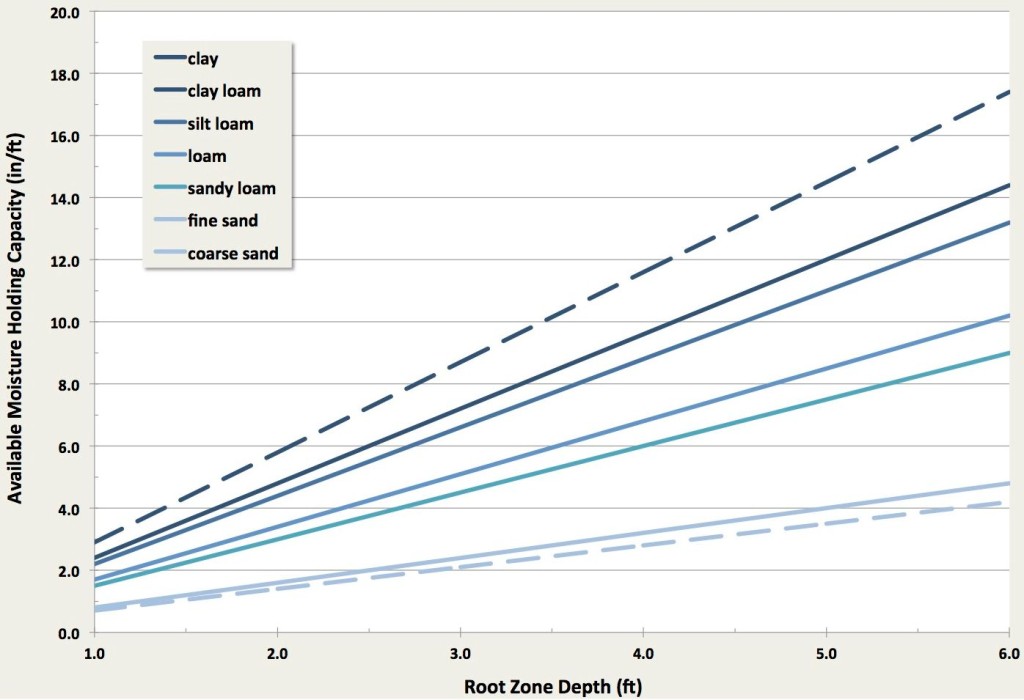
Fig. 2. Estimated plant available water as a
function of root zone depth for selected soil textures.
Source: Progressive Viticulture, LLC ©
In many established vineyards, the preplant activities described above may be applied to the tractor rows, but usually to a more limited degree. Perhaps more critical is the management of the surfaces of vineyard floors. During the winter, cover crops provide ground cover and their roots make channels in soils (fig. 4). Their net effect is slowed surface water runoff and accelerated water infiltration, which boosts water storage. After the onset of the growing season, cover crop incorporation terminates their water consumption before it becomes significant and creates a vapor barrier of loose soil (i.e. a dust mulch) that conserves soil moisture. The added organic matter from decomposed cover crop residues also increases soil porosity, permeability, and water holding capacity within the root zone.
Water Use
After maximizing soil moisture storage capacity, it is important to use soil water frugally. Again, preplant is the time to begin. Select a rootstock that has a high degree of drought tolerance and an extensive root system that exploits a large root zone, such as 140R, 125AA, Freedom, and RS-3. Utilize a spacing-training-trellising-pruning system that maximizes leaf exposure (i.e. minimizes leaf shading) and optimizes photosynthetic efficiency (fig. 5). These two factors contribute to high vine water use efficiency.
After planting, deep till, amend, and utilize cover crops as described above to maintain root zone conditions that favor vine water acquisition and use efficiency. Use management practices that sustain healthy leaves, limit their number to 12 to 20 per shoot with two clusters, and promote their exposure to sunlight. Employ a regulated deficit irrigation schedule that sustains moderate grapevine water stress after canopies fully develop. (Well nourished grapevines under moderate water stress use water more efficiently for growth and fruit production than well water vines.) Also, promote root elongation during both the spring and autumn flushes of root growth through thoughtful water and mineral nutrient management.
Finally, carefully monitor moisture within the vineyard and use this information to fine tune water management practices. Complete vineyard moisture monitoring includes the atmospheric moisture demand (evapotranspiration or ET) and degree of vine water stress, as well as soil moisture status (fig. 6).
Water Delivery
Effective irrigation water delivery is the final component of effective vineyard water management. In this effort, install and maintain an irrigation system that uniformly applies water across the vineyard at a rate the matches the soil intake rate when wet. Also, schedule irrigations at regular intervals and for durations that match vine water needs, while at the same time, that do not exceed the root zones capacity to hold moisture (i.e. that avoid deep percolation).
To summarize, the goals of comprehensive vineyard water management are optimal storage and use of rainwater, effective applications of irrigation water, and maximum vineyard water use efficiency. Achieving these involves careful vineyard design and development, and consistent management of soils and vines over the life of the vineyard.
Further Reading
- Goldhammer, DA; Snyder, RL. Irrigation scheduling: a guide for efficient on-farm water management. University of California, Division of Agriculture and Natural Resources Publication 1989.
- Grant, S. Five-step irrigation schedule: promoting fruit quality and vine health. Practical Winery and Vineyard. 21(1): 46-52 and 75. May/June 2000.
- Hanson, B; Orloff, S; Sanden, B. Monitoring soil moisture for irrigation water management. University of California Agriculture and Natural Resources Publication 21635. 2007.
- Kramer, PJ. Water relations of plants. Academic Press, San Diego, CA. 1983.
- Luebs, RE. Water conservation: Pacific Southwest. In: Dryland Agriculture. Dregne, HE; Willis, WO (Ed.). Am. Soc. Agron., Madison, WI. 1983.
- Prichard, TL; Hanson B; Schwankl, L; Verdegaal, P; Smith, R. Deficit irrigation of quality winegrapes using micro-irrigation techniques. University of California Cooperative Extension, Department of Land, Air, Water Resources, University of California, Davis. 2004.
- Prichard, T; Storm, CP; Ohmart, CP. Chapter 5, Water management. In: Lodi Winegrower’s Workbook, 2nd Ed. Ohmart, CP, Storm, CP, Matthiasson, SK (Ed.). Lodi Winegrape Commission. pp. 142-186. 2008.
- Robbins, JS. Reducing irrigation requirements. In Hagan, RM; Haise, HR; Edminster, TW (Ed.). Irrigation of Agricultural Lands. Am. Soc. Agron., Madison, WI. 1967.

